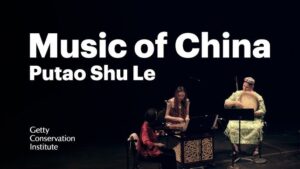 Much of what we know about ancient Chinese music comes from historical texts, such as The Book of Songs (Shijing) and writings from Confucian scholars. These texts often focused on the philosophical and cultural contexts of music rather than its practical performance aspects, limiting broader discussion. Cultural Revolution Impact: The Cultural Revolution (1966-1976) significantly disrupted traditional arts, including music. Many ancient practices were lost or suppressed, leading to a gap in cultural transmission and a diminished public interest in ancient music forms. Modern Musical Influence: Contemporary Chinese music has been heavily influenced by Western styles and modern genres, overshadowing traditional forms. As a result, ancient music is often seen as less relevant in today’s music scene. Educational Focus: Modern education in China tends to prioritize contemporary music and art forms, with less emphasis on ancient practices. This has contributed to a lack of familiarity with ancient music among younger generations. Lack of Performance Traditions: Many ancient musical forms have no direct modern counterparts or performance traditions, making it difficult for them to be revived or appreciated in contemporary contexts. Complexity and Accessibility: Ancient Chinese music often involves complex theoretical frameworks and instruments that are not easily accessible or understood by the general public, contributing to its marginalization. Regional Variations: China has a vast array of regional musical styles, and ancient music is often interwoven with local customs. This diversity can make it challenging to present a unified narrative about ancient music as a whole. Limited Research and Funding: Research into ancient music may receive less funding and academic attention compared to other cultural areas, leading to fewer resources and public discussions about its significance. Cultural Identity: In contemporary discussions, there may be a tendency to emphasize modern Chinese identity and expressions, sometimes sidelining ancient traditions as part of a historical narrative rather than a living practice. Revival Efforts: Despite these challenges, there are ongoing efforts by musicians and scholars to revive and reinterpret ancient Chinese music, creating new interest and awareness in various cultural circles. However, these initiatives often remain niche and not widely publicized. By understanding these factors, we can appreciate the complexities surrounding the discussion of ancient Chinese music and the ongoing efforts to preserve and revitalize these important cultural expressions.
Much of what we know about ancient Chinese music comes from historical texts, such as The Book of Songs (Shijing) and writings from Confucian scholars. These texts often focused on the philosophical and cultural contexts of music rather than its practical performance aspects, limiting broader discussion. Cultural Revolution Impact: The Cultural Revolution (1966-1976) significantly disrupted traditional arts, including music. Many ancient practices were lost or suppressed, leading to a gap in cultural transmission and a diminished public interest in ancient music forms. Modern Musical Influence: Contemporary Chinese music has been heavily influenced by Western styles and modern genres, overshadowing traditional forms. As a result, ancient music is often seen as less relevant in today’s music scene. Educational Focus: Modern education in China tends to prioritize contemporary music and art forms, with less emphasis on ancient practices. This has contributed to a lack of familiarity with ancient music among younger generations. Lack of Performance Traditions: Many ancient musical forms have no direct modern counterparts or performance traditions, making it difficult for them to be revived or appreciated in contemporary contexts. Complexity and Accessibility: Ancient Chinese music often involves complex theoretical frameworks and instruments that are not easily accessible or understood by the general public, contributing to its marginalization. Regional Variations: China has a vast array of regional musical styles, and ancient music is often interwoven with local customs. This diversity can make it challenging to present a unified narrative about ancient music as a whole. Limited Research and Funding: Research into ancient music may receive less funding and academic attention compared to other cultural areas, leading to fewer resources and public discussions about its significance. Cultural Identity: In contemporary discussions, there may be a tendency to emphasize modern Chinese identity and expressions, sometimes sidelining ancient traditions as part of a historical narrative rather than a living practice. Revival Efforts: Despite these challenges, there are ongoing efforts by musicians and scholars to revive and reinterpret ancient Chinese music, creating new interest and awareness in various cultural circles. However, these initiatives often remain niche and not widely publicized. By understanding these factors, we can appreciate the complexities surrounding the discussion of ancient Chinese music and the ongoing efforts to preserve and revitalize these important cultural expressions.